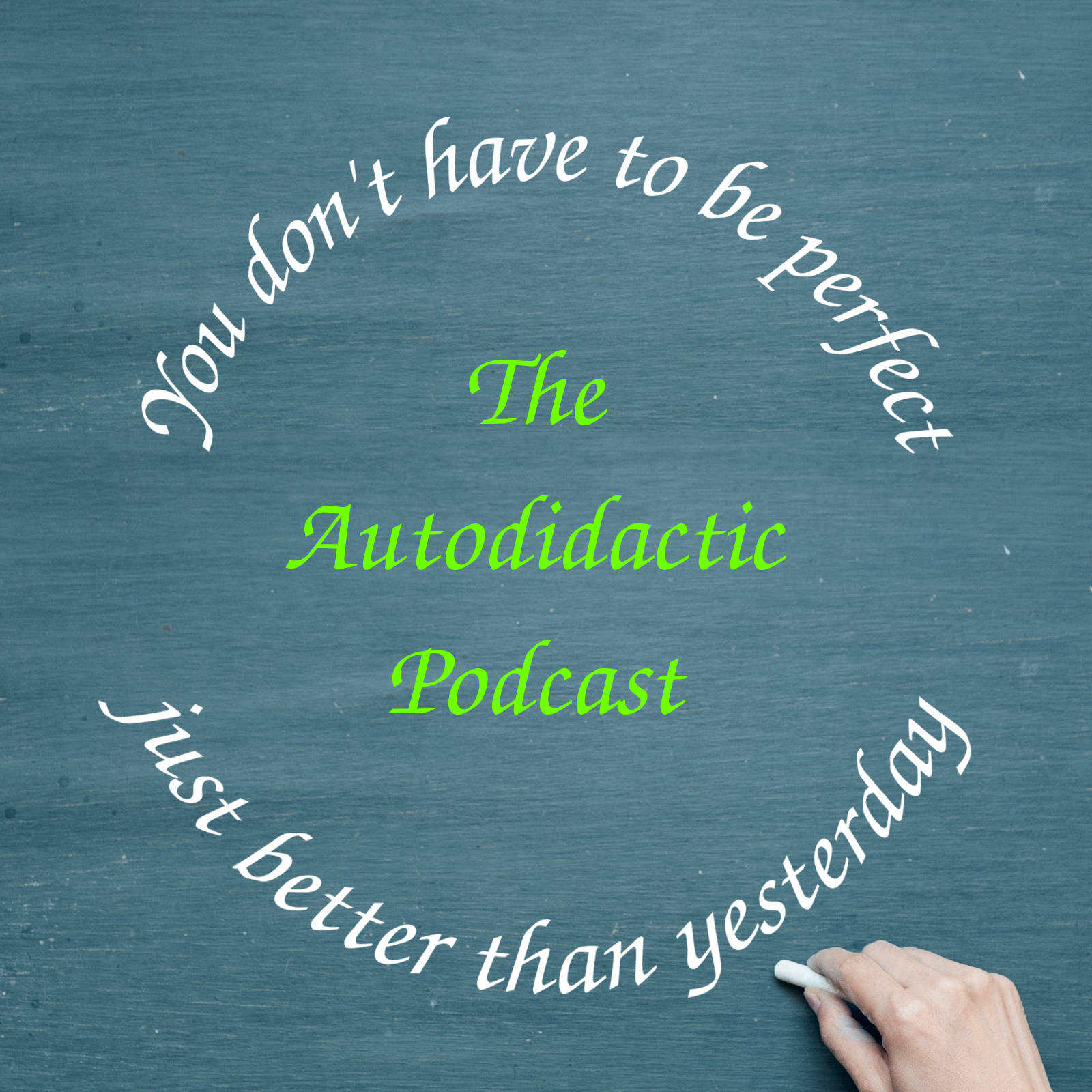
Subscribe to my Author Newsletter
Welcome to the audodidactic podcast season three, episode three. If you’re a new listener welcome aboard and if your a returning listener welcome back.
In season one I covered a lot of the methods regarding how to be an autodidactic, and in season two I covered autodidactics of the past and some of the methods they used for self learning. This season I’m doing a series called “My Destupidifacation”. I will be using all of the techniques and methods I’ve discussed previously to show these techniques in action. However, since a lot of the techniques require some elements that are best shown visually I decided to show what I’m doing on my YouTube channel.
I’ve really been struggling to do all of the study for this season and all of the projects I have ongoing. I counted up all the projects I have and I’ve got 21 project in trail right now. You may be aware that I write books both fiction and non-fiction. I’ve got two fiction books to complete which are already twelve months over due, and I’ve got a non-fiction book proposal to complete before the end of next month. I’ll put some links in the show notes if anyone is interested.
Later in the season I’m going to try and cover off some time management techniques I’ve been using, but also show how to prioritize and juggle some tasks.
However, this week on the Autodidactic podcast I’m going to look at textbook study, and creation of quizzes for yourself as you learn.
I’ve done two complete episodes on textbooks studies in season one. Episode seven and episode eight are both about studying textbooks. I recommend you listen to both of these if you haven’t already done so.
In season one, episode seven I discussed how to read a textbook to increase comprehension and retention of information using one of the three different study methods I described. These three methods were: P2R, SQ3R and S-SUN-R. There are probably at least a dozen different systems developed to help students understand what they read, and they’re all very similar but these are three of the most popular. You probably want to use a combination of these methods.
The first one we’re gonna talk about is a three step approach called P2R (or Previewing, Reading and Reviewing) and it’s designed for textbooks from easy to average level of difficulty. This isn’t for the really difficulty or information dense textbooks, but easier level or average level.
The first step is to preview a chunk of the textbook, e.g. ten pages, one section, one chapter. Something small and defined. You skim through this section, reading the section headings, or first sentence of the paragraphs, anything in bold print or italics, have a look at any figures, tables or charts. While you are doing this note down any questions this might bring up. You’ll try to look out for answers to your questions when you start active reading.
Once you’ve previewed, write down any information you gleaned while previewing Right yourself some sample questions, write a brief summary of what you think you’re going to get and then move on to active reading.
During active reading you are typically highlighting things, or putting notes in the margins, or writing in your notebook. Keep in mind when you’re when you’re highlighting. You’re just trying to highlight things that will be useful and relevant in summary later.
After you’ve completed your chunk of reading or at the end of the chapter, you need to review and do something to reinforce the important information. Now there’s a number of ways that you can review the text material, but the four most common ones are.
- First, you look at your highlighted entries or the notes, and you read them aloud. You write questions in the margin of your text or notes at the end of each chunk, and then when you finished reading the entire chapter, you recite the answers to your questions
- Secondly, used the headings to recite the key information on cover the details with your hand and then recite using only the headings as a clue.
- The third ways to do some or any exercises or questions they may have at the end of chapter. Many textbooks have this sort of thing, at the end of chapters.
- And finally, you can take the end of chapter tests or online test to review and monitor what you’re learning.
You can use SQ3R for more complex textbooks, but you can also use it for the easy ones.
SQ3R was developed by a fellow called Frances Robinson in 1941 on is probably one of the most widely taught system. SQ3R is an acronym for Survey, Question, Read, Recite, Review. And this time we have five steps.
the five steps are:
Survey- you survey the chapter before you read it. You go through the chapter quickly, you glance at the headings, you read the final paragraph to get a general idea and the main points so very similar to the previous method and then question.
Question – Before you begin to read each headed section of your chapter, you turn the heading into a question. For example, you may have a heading “housing population” and so you would typically turn that into a question.
Read – So the next step is to read the material underneath the heading to try and find the answer to the question which you generated. Turning heading into a question helps you focus your reading, and the reading in this section helps you locate the answer to your question. Hopefully, and so you’ll get actively involved in the reading material. As you read the selection, see if you can answer your question and then the next bit is recite.
Recite – So at the end of the section the headed section, recite the answer to the question that you formulated. Recite the answer in your own words, though, so that it’s a summary without looking back at the text. And if you can’t recall part or all of the answer, then go back to the section again and then try and jot down the answer in a sort of an outline or a summary form. But don’t take any notes until you’ve read the entire section, and then the next step, the final step is review.
Review – So after you finished reading through entire chapter, look over the notes that you made to familiarize yourself with the important information and then check your memory by covering up your notes and reciting the main points out loud, and then cover each point in your notes and recite subordinate points that you’ve noted. So this type of review should only take five minutes because you’re only review in a very small subset of what you’ve, that you’re only studying a small subset.
The final system I want to talk to you about is called S-RUN-R. The S-RUN-R system was developed by a lady Nancy Bailey. This combines review steps to better help you with your comprehension because you’re focusing on one section at the time. This is also a useful technique for difficult or advanced textbooks which are, information dense.
The five steps here are:
S, survey
R, read
U, underline,
N, note taking
R, review
I cover this in detail in the season one, episode seven podcast and it would take too long to got through it all again here, so I recommend you go back the listen to that podcast. The advantage of using this particular system is that it highlights all the important information in every section in every paragraph, and it increases repetition as well, because you get more repetition of the important points because you’re not just highlighting it.
So how do you go about marking up your textbook? The main two methods are underlining or marking with a pencil. You can use either, but I would recommend that you use a highlighter, since this forces you to read a second time. You might think you get the same effect with underlining but studies have shown that people tend to look at the pencil like rather than the words. Highlighting doesn’t have this disadvantage.
When marking, markup sentences where possible. If you ‘re highlighting keywords, then you need to use linking to connect them together. While marking just try to remember to mark things in a way that they’ll make sense when you review a month or six months later. This is why it is better to mark meaningful phrases instead of just words.
Diversity is great, but not when it comes to text highlighting. You’ve probably seen people who have 10 different colour highlighters and they have one colour for facts, one for opinion, one for keywords, another colour for examples, etcetera. I would advise against this. It makes you think more about the colouring than the content. Using two colours is really the maximum.
What to mark? Headings, subheadings, main ideas, supporting details, definitions, examples, and statistics are important. Mark the main ideas of the section. Main ideas are the general statements that the author makes about the topic. The main idea statement, or topic sentence, is generally found in the first or second sentence of a paragraph.
Look for definitions, examples, facts, statistics, and signal words. Lists or enumerations, like definitions, should almost always be highlighted. Don’t omit information included in charts, graphs, and other diagrams. The information under photos, in footnotes, and in boxed features is also important to your understanding of the material.
For Math or Science books make sure to highlight all formulas, as well as any problems.
Remember you don’t want to over mark, it will simply increase your review times! If you highlight everything, you might as well just read the book again.
Be sure you’re not under-marking as well. You need to get all the important information, and not miss anything, without marking too much. So you need to be like goldilocks and mark it just right. Practice will help here more than anything else. As you get experience in marking and reviewing later you’ll find the sweet spot.
You also need to use your highlighting to generate self-tests and quizzes. You use these markings and turn them into questions which your future self can be tested on and review. It will help you to solidify your knowledge and make sure you’re retaining what you need.
I’ll show you on the YouTube channel how I use a pdf reader called Okular to highlight pdf’s and show you how to generate quizzes into text files which can then be combined into tests or examinations.
I will post any links to the YouTube channel on the autodidactic website and in the transcription of this podcast. The transcriptions and the links are at https://autodidactic.info
If you have any comments or suggestions regarding this series or any of the previous series you can contact me at rick@autodidactic.info. Or post a comment on the website or on the YouTube channel.
That you for listening and I hope to see you next week.

